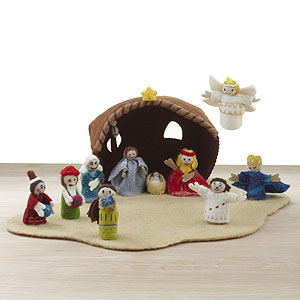Advent is here!
For Catholics, the Christmas “season” doesn’t begin until Christmas Eve. Until then, we have Advent, a season of longing and waiting. It’s a penitential and reflective season, a time when we recall with gratitude the Incarnation, and we look forward to Christ’s Second Coming.
Our kids might forget this deeper meaning sometimes because of the impact of advertising and the light shows in the neighborhoods, and really, that’s okay. Through our family faith traditions and rituals, we can remind our children of the more profound significance of this month leading up to December 25.
A place to start: perhaps we can set aside ten minutes a day to spend in family prayer. Here are some Advent prayer traditions that you might consider. Most of you probably already use an Advent wreath of some sort, with accompanying prayers, so I won’t cover the Advent wreath here.
I’m providing printables of most of the prayers rather than typing all the prayers out, as some of the sequences are quite long, and this way you can have a copy of the prayers for everyone in your family. Most of these prayers are adapted from Catholic Household Blessings and Prayers published by the United States Conference of Catholic Bishops.
Blessing the Nativity and Tree
Some families wait until Christmas Eve to put out any Christmas decorations, and I do see the wisdom in this. But, I’m sure I would never take out anything if I had to do it all in one day! I have a different approach, one that I think is still appropriately reverent for Advent. I take out Christmas decorations very gradually to build the anticipation.
Nativity Scene
First, I set up our nativity scenes. My favorites are a felted set I purchased when my kids were small and a vintage “santon” nativity from Provence.

In Germany, families wait until Christmas Eve to place the baby Jesus in the manger. If you want to do this, too, here’s a great idea: Have a box of straw or fabric near your nativity. Each time one of your children does a kind deed during Advent, he or she can place bits of straw or fabric in the empty manger. Then on Christmas Eve, they will have prepared a lovely soft bed for Jesus!
Christmas Tree
It’s also traditional to wait until Christmas Eve to decorate the Christmas tree, and the Christmas tree remains up until the Feast of the Epiphany on January 6. In some countries, the tree is left up until Candlemas on February 2! In my family, as with the Nativity, we put up our tree earlier than the tradition suggests. We usually get our tree on Gaudete Sunday, which is the third Sunday of Advent, and we decorate it sometime during the following week.
Here is a printable version of traditional prayers you can pray as a family to bless your nativity and/or tree.
Nativity and Tree Blessings printableDownload
TIP: If you’re going to bless your tree, decorate it first, but don’t turn on the lights. The blessing happens after the tree is decorated with ornaments, but the tree is illuminated for the first time during the blessing. So beautiful.
St. Andrews Novena (November 30)
Beginning on November 30, the Feast of St. Andrew the Apostle, the St. Andrew’s Novena is traditionally recited fifteen times a day until Christmas. No doubt, this might be too much for small children! I would suggest praying it once in the morning, afternoon, and/or evening, perhaps when lighting your Advent candles. This is a beautiful and meditative prayer that helps our families remain focused on Christ’s coming and the real meaning of Christmas!
Hail and blessed be the hour and moment in which the Son of God was born of the most pure Virgin Mary, at midnight, in Bethlehem, in the piercing cold. In that hour vouchsafe, I beseech Thee, O my God, to hear my prayer and grant my desires [insert your petitions here] through the merits of Our Savior Jesus Christ, and of His blessed Mother. Amen.
Here is a printable with four prayer cards per sheet:
St. Andrew’s Novena printableDownload
Visio Divina
Visio divina is an adaptation of lectio divina (divine reading). Lectio divina is an old monastic form of meditation on a passage from scripture. Four stages (or movements) in lectio take you deeper into contemplating the scripture passage. For years, I had trouble finding a decent Advent lectio divina to use with my children, so I decided to put together my own! Here is my free “Advent Lectio Divina for Families” guide.
For this article, I want to point you to visio divina, which is a twist on lectio divina. In visia divina, instead of using scripture for your reflections, you use images (or you can use images along with scripture). Often, young children are sensitive to artistic and visual beauty, so they may benefit from visio divina when lectio feels too abstract for them.
You can use any kind of image, including sacred art, nature scenes, or illustrations in a children’s Bible. As your family prays together with the image, imagine yourself in the scene or simply gaze upon the image as God reveals his Truth, Beauty, and Goodness to you.
I came across this awesome slideshow that uses sacred art for a family Advent visio divina. (Credit to Katie at Look to Him and Be Radiant.) There’s an image to contemplate for each day of Advent.
The O Antiphons (December 17 to December 23)
The “O” Antiphons are seven verses that are recited during Evening Prayer (Vespers) in the Divine Office from December 17-23. These are short prayers that would work well with children of all ages. The antiphons use titles of the Messiah, based on the prophecies of Isaiah. The prayers are simple yet stunning reflections of the hope we have in Christ. The O Antiphons inspired many Advent hymns, including “O Come, O Come Emmanuel.”
Here’s the first one (for December 17) to give you an idea:
O Wisdom of our God Most High,
guiding creation with power and love:
come to teach us the path of knowledge!
Here is a printable with all the Antiphons; two per sheet:
Idea: Maybe after dinner each evening beginning December 17, your family can pray a decade of the Rosary followed by the Antiphons. Or you can pray the Antiphons as part of your table blessing, when you light your Advent candles, or at bedtime.
Fun fact for your kids: When you take the first letter in the titles for the Messiah in Latin, then reverse them, they spell “ero cras” which is translated “tomorrow, I will come.” This is not an accident. On the 23rd when we finish the Antiphons, Christ says to us, “I’m coming!”
Jesse Tree (each day during Advent)
Having a Jesse tree is an old Christian tradition, dating back at least to medieval times. In fact, it may be the original “Christmas tree.”
The Jesse tree takes its name from Isaiah 11:1: “A shoot shall come out of the stock of Jesse, and a branch shall grow out of his roots.” Jesse was the father of King David so this verse is seen as a prophecy not only of the birth of King David, but the coming of the Messiah, Jesus Christ.
The “tree” is usually just a big branch stuck in a pot or vase; you add one ornament to the branch each day during Advent. The ornaments represent the stories in the Old Testament that foreshadow the birth of Christ. You read the relevant scripture, pray a prayer each day, and the child hangs an ornament on the branch. It really is a beautiful way to share with your kids the way God has protected and led his people for millennia.
We did the Jesse tree in my home during Advent for many years, but we tended to fizzle out toward the end of Advent. Last year, we didn’t do it. I’m not sure why because we really enjoy this tradition. It may have been the resource we used. I might try something new this year. There are so many more resources available now than when I first tried the Jesse tree. You can find gorgeous Jesse tree ornaments on Etsy or Amazon, or you can make your own.
Here is a free resource from CathFamily, including scripture readings, prayers, and printable ornaments.
***
You don’t need to use all of these ideas, but maybe you can add one or two of them to your family prayer plans during Advent. When we lead our children in prayer at any time, we are encouraging their encounter with the Divine, and during Advent this is especially fruitful when our children become immersed in stories about the Incarnation. Come, Emmanuel!

